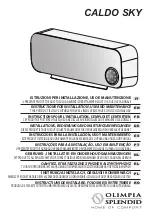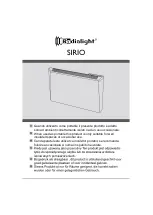
Handling and installation
While all equipment is designed for durability and
fabricated with heavy gauge materials and may
present a robust appearance, great care must be
taken to assure that no undue force is applied to the
coil, piping, or other delicate components such as
control boards during handling. Wherever possible,
all units should be maintained in an upright position
and handled by the chassis, plenum sections or as
close as possible to the mounting points. In the case
of a fully exposed cabinet unit, the unit must obviously
by handled by the exterior casing. Gloves should be
worn when handling finished, painted units and should
never be set down on unclean, hard surfaces. Failure
to follow these instructions may lead to scratching or
gouging of the finished surface.
Although Zehnder Rittling does not become involved
with the design and selection of support methods
and/or components, it should be recognized that
unacceptable operating characteristics and/or
performance may result from poorly implemented
unit support. Additionally, proper clearance must be
provided for service and removal of the equipment.
Anchoring the equipment in place is accomplished by
using the mounting points provided, and positioning
the unit on a LEVEL plane. Vertical units are designed
to be bolted to the wall structure through the slotted
wall mounting holes in the chassis, used for anchoring
to pre-installed wall studs. Horizontal units are
provided with slotted ceiling mounting brackets where
hanging rod and rubber-in-shear or spring vibration
isolators, supplied by others, can be used for proper
suspension and vibration isolation.
The type of mounting device is a matter of choice,
however the mounting point should always be that
provided in the chassis or cabinet.
Improper mounting could result in the unit falling from
its position, causing personal injury or even death.
After mounting the unit, it is then ready for the various
service connections such as water and electrical. At
this time it should be verified that the proper types of
services are actually provided to the unit. On those
units requiring hot water, the proper line size and
water temperature should be available to the unit.
On units with steam heating coils, the proper line
sizing and routing should be verified. The maximum
steam pressure should never exceed 15 psig. The
drain piping and steam trap, supplied by others,
should be sized and routed to allow for proper
condensate flow.
The electrical service to the unit should be compared
to the unit nameplate to verify compatibility. The
routing and sizing of all piping, and the type and sizing
of all wiring and other electrical components such as
circuit breakers, disconnect switches, etc., should
be determined by the individual job requirements
and should not be based on the size and/or type of
connection(s) provided on the equipment. Verify the
electrical conductor size is suitable for the distance
to the equipment connection and will support the
equipment electrical load. All installations should
be made in compliance with all governing codes
and ordinances. Compliance with all codes is the
responsibility of the installing contractor.
14
















































